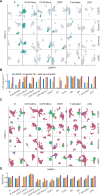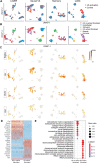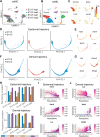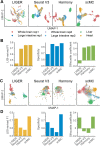scMC learns biological variation through the alignment of multiple single-cell genomics datasets
- PMID: 33397454
- PMCID: PMC7784288
- DOI: 10.1186/s13059-020-02238-2
scMC learns biological variation through the alignment of multiple single-cell genomics datasets
Abstract
Distinguishing biological from technical variation is crucial when integrating and comparing single-cell genomics datasets across different experiments. Existing methods lack the capability in explicitly distinguishing these two variations, often leading to the removal of both variations. Here, we present an integration method scMC to remove the technical variation while preserving the intrinsic biological variation. scMC learns biological variation via variance analysis to subtract technical variation inferred in an unsupervised manner. Application of scMC to both simulated and real datasets from single-cell RNA-seq and ATAC-seq experiments demonstrates its capability of detecting context-shared and context-specific biological signals via accurate alignment.
Keywords: Single-cell genomics data, Data integration, Biological variation, Technical variation, Batch effect removal.
Conflict of interest statement
The authors declare no competing interests.
Figures







Similar articles
-
iMAP: integration of multiple single-cell datasets by adversarial paired transfer networks.Genome Biol. 2021 Feb 18;22(1):63. doi: 10.1186/s13059-021-02280-8. Genome Biol. 2021. PMID: 33602306 Free PMC article.
-
Benchmarking atlas-level data integration in single-cell genomics.Nat Methods. 2022 Jan;19(1):41-50. doi: 10.1038/s41592-021-01336-8. Epub 2021 Dec 23. Nat Methods. 2022. PMID: 34949812 Free PMC article.
-
Joint analysis of scATAC-seq datasets using epiConv.BMC Bioinformatics. 2022 Jul 29;23(1):309. doi: 10.1186/s12859-022-04858-w. BMC Bioinformatics. 2022. PMID: 35906531 Free PMC article.
-
From reads to insight: a hitchhiker's guide to ATAC-seq data analysis.Genome Biol. 2020 Feb 3;21(1):22. doi: 10.1186/s13059-020-1929-3. Genome Biol. 2020. PMID: 32014034 Free PMC article. Review.
-
Single-cell sequencing techniques from individual to multiomics analyses.Exp Mol Med. 2020 Sep;52(9):1419-1427. doi: 10.1038/s12276-020-00499-2. Epub 2020 Sep 15. Exp Mol Med. 2020. PMID: 32929221 Free PMC article. Review.
Cited by
-
A unified computational framework for single-cell data integration with optimal transport.Nat Commun. 2022 Dec 1;13(1):7419. doi: 10.1038/s41467-022-35094-8. Nat Commun. 2022. PMID: 36456571 Free PMC article.
-
Spatial Transcriptomics of Intraductal Papillary Mucinous Neoplasms of the Pancreas Identifies NKX6-2 as a Driver of Gastric Differentiation and Indolent Biological Potential.Cancer Discov. 2023 Aug 4;13(8):1844-1861. doi: 10.1158/2159-8290.CD-22-1200. Cancer Discov. 2023. PMID: 37285225 Free PMC article.
-
Leveraging gene correlations in single cell transcriptomic data.BMC Bioinformatics. 2024 Sep 18;25(1):305. doi: 10.1186/s12859-024-05926-z. BMC Bioinformatics. 2024. PMID: 39294560 Free PMC article.
-
Integrating multiple spatial transcriptomics data using community-enhanced graph contrastive learning.PLoS Comput Biol. 2025 Apr 3;21(4):e1012948. doi: 10.1371/journal.pcbi.1012948. eCollection 2025 Apr. PLoS Comput Biol. 2025. PMID: 40179111 Free PMC article.
-
Detecting novel cell type in single-cell chromatin accessibility data via open-set domain adaptation.Brief Bioinform. 2024 Jul 25;25(5):bbae370. doi: 10.1093/bib/bbae370. Brief Bioinform. 2024. PMID: 39073828 Free PMC article.
References
Publication types
MeSH terms
Grants and funding
LinkOut - more resources
Full Text Sources
Other Literature Sources

